MEMORIES
OF OSCEOLA, FLORIDA
By
Mary (Riley) Henderson
I was the first Riley child
born in Osceola, Florida, on January 2, 1921, delivered by Dr. W. H. Martin.
I was 15 when we left there, so my memories are through the eyes of a
young teen. My dad, John F. Riley, was the Superintendent of the Osceola
Cypress Mill. He indeed bossed
everybody and he hired and fired. My
mother, Clara (Erwin) Riley, was the mother of us seven children:
John Francis, Kathleen, Nora, Mary, Alice, Bill, and Pete.
She was famous for her good cooking.
We especially liked the peanut butter fudge.
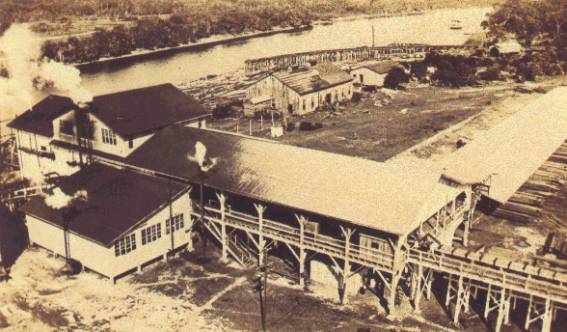 Our
town was small and kinda isolated but we didn’t lack anything, you know; we
were kinda modern for those days. A
paved road brought you in and you went out the same way you came in.
At the end of the road you came face to face with the Big Mill (the
Industrial Park), a sawmill, planing mill, lumber yard and some small shops that
kept things in running order. There
were two big engines, No. 10 and No. 50. No. 50 had its own name, Summersill, because he was the driver. It
went on the East Coast Railroad Lines to far away places like Okeechobee to pick
up logs from the cypress swamps. No. 10 stayed on local tracks and moved the logs around.
They were dumped into a log pond on the St. Johns River and then were run
through the sawmill and planing mill, then to lumber yard to drier.
A funny little machine called a Ross Carrier moved the lumber around to
different places.
Our
town was small and kinda isolated but we didn’t lack anything, you know; we
were kinda modern for those days. A
paved road brought you in and you went out the same way you came in.
At the end of the road you came face to face with the Big Mill (the
Industrial Park), a sawmill, planing mill, lumber yard and some small shops that
kept things in running order. There
were two big engines, No. 10 and No. 50. No. 50 had its own name, Summersill, because he was the driver. It
went on the East Coast Railroad Lines to far away places like Okeechobee to pick
up logs from the cypress swamps. No. 10 stayed on local tracks and moved the logs around.
They were dumped into a log pond on the St. Johns River and then were run
through the sawmill and planing mill, then to lumber yard to drier.
A funny little machine called a Ross Carrier moved the lumber around to
different places.
Turning around and coming
back out from the mill (see map at end of article), first on the right was the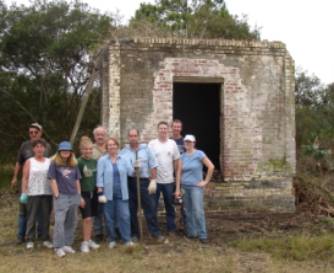 Business Area (the office complex). It was one building with about four offices
in it, plus the bank. The bank was a big brick vault where they kept coupons
that were used for money, plus some real money too. It got robbed once! What great excitement! The old vault is
still standing there as a silent reminder of bygone days.
(Photo at right is of 2004 Cleanup Crew trying to preserve the Osceola Vault)
Business Area (the office complex). It was one building with about four offices
in it, plus the bank. The bank was a big brick vault where they kept coupons
that were used for money, plus some real money too. It got robbed once! What great excitement! The old vault is
still standing there as a silent reminder of bygone days.
(Photo at right is of 2004 Cleanup Crew trying to preserve the Osceola Vault)
Next came the Shopping Center.
We called it a Commissary. Kinda
like a small Wal-Mart. You could buy most anything from overalls to penny candy.
Everything was served over the counter, which kept you away from the
merchandise. On the Meat Counter was a big roller of wrapping paper and a big
glass jar of pickled pigs feet, mmm good! On the Clothes Counter were two slot
machines, used freely while one waited their turn to be waited on.
We kids even sacrificed a nickel or two if we could get past the Candy
Counter. Oh! the Candy Counter! It
was a Glass Show Case. It had big
Baby Ruth bars, maybe 8 inches long.
We thought they were named after Babe Ruth, our baseball idol.
Also had Hershey Bars, all day
suckers, gum balls, jaw breakers, bubble gum, Cracker Jacks,
prize candy, balloon candy, candy kisses, licorice,
Black Cows, penny candy. Under the
Grocery Counter they had the makin’s for Home Brew.
Some got pretty good at making their own. Oh yes, we had pop: Orange
Crush, Root Beer, and Coca- Cola which everyone called dopes.
You know, I think they really were!
They also had powdered milk
called KLIM - milk spelled backwards. It
was mostly for babies. They always had a good supply of penny pencils and nickel
tablets. There were spittoons on
the floor for those who chewed Red Mule, or was it Red Apple tobacco? Some users
weren’t very good aimers, ugh!
We also had our own Home
Shopping Center. Good old Sears
Roebuck Catalog! What a treasure!
The old catalog provided good paper dolls when the new ones came in the
mail.
The Filling Station was in
front of the Commissary. It was a
lot like our modern filling stations today.
You pumped your own gas by hand, up into big glass containers that
measured it and then let it down by hose into the tank.
You paid in the store. Yes,
the pump was kept locked. You had
to ask for a key.
Next came the
accommodations, called a Boarding House. It
had bedrooms with iron bedsteads with flat springs and cotton mattresses and a
mirrored dresser. You learned early
to never shut the drawers all-the-way-in, or you might never get them open
again. It had a big kitchen and wooden tables where meals were served by those
in charge. I remember Mrs. T. C.
Fuller -- she gave me a dollar once -- never been so rich in all my life. They
later moved to Georgia to cook for the state prison there.
Next came the Professional
Building. The doctor’s office was
first, served by Dr. W. H. Martin, and then by Dr. T. G. Moore.
They did everything from delivering babies to removing splinters.
The Post Office was next.
Mrs. Ritchie was Post Master. The mail came in on the mail train that
dropped it off at the railroad station about one-half mile away on the East
Coast Rail Line. It was picked up and brought to the Post Office, sorted and
put in individual mailboxes with combination locks. Always they had big posters on the front of the Post Office
advertising the latest movies being shown in Sanford.
The third and last was the
Barber Shop. Dick, a black man, was
the barber. He kept the girls’
hair in the latest style, whether shingled or bowl cut.
He cut the men’s hair too, and even shaved some of them.
He sharpened his razor on a big leather razor strop.
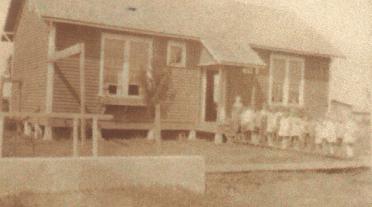 School comes next: a Little Red School House. Our teachers came from Geneva mostly. We remember Mrs. M. E. Dooley best. She ruled us with a big fat ruler -- could give a real sting
to one’s hand! She gave us
crystallized grapefruit for Christmas. She
made us learn lots of poems. She
had a stereopticon viewer, which showed 3-D pictures of World War I, wow!
What an invention! We thought, what would they think of next?
She told us the capitol of Florida was going to be moved to Orlando: “Shouldn’t ever
have been put a-way up there in Tallahassee in the first place.” We’re
still waiting - maybe Disney has put a stop to that rumor.
Mr. Lawton, Superintendent of Seminole County schools, came to check on
us once a year. We thought he was
awesome. Some people used the schoolhouse for Sunday school and church.
We didn’t have a church building.
School comes next: a Little Red School House. Our teachers came from Geneva mostly. We remember Mrs. M. E. Dooley best. She ruled us with a big fat ruler -- could give a real sting
to one’s hand! She gave us
crystallized grapefruit for Christmas. She
made us learn lots of poems. She
had a stereopticon viewer, which showed 3-D pictures of World War I, wow!
What an invention! We thought, what would they think of next?
She told us the capitol of Florida was going to be moved to Orlando: “Shouldn’t ever
have been put a-way up there in Tallahassee in the first place.” We’re
still waiting - maybe Disney has put a stop to that rumor.
Mr. Lawton, Superintendent of Seminole County schools, came to check on
us once a year. We thought he was
awesome. Some people used the schoolhouse for Sunday school and church.
We didn’t have a church building.
Next comes the Residential
Area:
Ø First
was for the Elite. Mr. and Mrs.
Peter Feitner lived there on a House Boat, anchored in the St Johns River.
He drove a big car, maybe a Cadillac?
He came from up north. He
was a banker too -- even had his name printed on a dollar bill.
Ø Second
was the Main Street. The white-collar workers lived there in big houses: Lands,
Rileys, Redpaths, Haldemans and Moores. They
took care of all business of the mill.
Ø Third was
what we called the other row in smaller houses.
They were maybe the blue-collar workers.
They mostly held the main working positions in the mill: Meyers,
Paramores, Silvers, McLaughlins, Geigers, Fews, Wilcoxes, Roberts, etc.
Ø Fourth was
the colored quarters (a term of respect). They
took care of the many jobs connected to the millwork.
They had their own school and church and Juke joint.
There were Carrie, Bee, Annie Bee, Christopher, and Robert Meriweather,
etc. They lived in small portable houses.
Ø Fifth were
the other people who owned their own property across the railroad tracks
bordering the river, not connected with the mill:
the Ritchies, Metcalfs, and Lindseys.
Ø Sixth was
the railroad - the Georges who operated the railroad draw bridge over the St
Johns River, and the Hollamans who kept the tracks in repair.
They lived in the Yellow houses near the bridge.
Ø Seventh:
Guess I should mention the cattle that freely roamed the land around us.
In spite of fences and cattle guards, they did come into town from time
to time - what a mess they made!
What was it like living in
Osceola? Our lives were ruled by
the saw mill and we were there to keep it alive and healthy.
A whistle blew to keep us all in step with things.
The first came in early morning, time to get up - another time to go to
work, another at lunch time and then one to go back to work.
Ah! At last the quitting
whistle. In return we were supplied
and equipped with many conveniences:
- Electricity
in all the homes. The mill
produced its own. The lights
were blinked at night when it was time to go to bed, and then OUT!
-- Did not come back on till the wake-up whistle blew.
- Running
water and flush toilets in the homes. Did
we bathe in that brown water? Yes! Did
we drink it? No!
But we had the best drinking water in all the world.
We hauled it from where else but Geneva.
Thanks Geneva!
- We
had white picket fences and St. Augustine lawns.
- Wooden
sidewalks -- boards, nail and bare feet - what a combination!
Stubbed toes, splinters, and nail scrapes!
- We
cooked on kerosene stoves, even tried a kerosene refrigerator, which was
kinda temperamental, kept warm with kerosene heater and fireplace.
- The
ice truck delivered ice to our door.
- The
night watchman watched over us all at nighttime.
- We
had washerwomen come do the laundry for us -- nine people produced lots of
it!
- Telephone
service. All the homes on Main Street had one.
You could listen in on everyone’s calls - kept us up with the news
that way. Had a switchboard in
Geneva run by Mrs. Lindsey. We could make long distance calls.
- Recreation,
what did we do for fun?
- Baseball
games - had a ball field with board bleachers near the “colored
quarters”. Don’t remember who made up the teams; but everybody cheered
everybody.
- Had
horseshoe games, and croquet games.
- Some
went to Sanford on Saturday nights - dog races, movies, or other things they
didn’t talk about. Some, in
secret places, played something called Bolita or was it Blackjack, or was it
both, or neither? Didn’t talk
much about it - think it was against the law.
- Ladies
had their Bridge parties. Met
in each other’s homes. Had
refreshments and prizes. The
kids had birthday parties.
- Halloween
parties - the big event in October.
- There
was the yearly picnic in Geneva at the old pavilion on Lake Harney.
- We
listened to our battery radios and wind-up victrolas.
- We
had the Osceola Four, a black quartet - they could really sing
-- they showed off to the big men from up north.
- The
black helpers supplied us with plenty of ghost stories.
- Went
fishing with bamboo poles - had the whole St Johns River - caught brim,
catfish, shiners. Used muscles and angleworms for bait.
- Older
boys had wooden boats with oars or kickers, or both, which took them on
exploration trips up and down the St Johns River.
- Picked
blackberries and huckleberries - alert for rattlesnakes all the time.
- Went
arrowhead hunting.
- Played
parlor games like spin-the-bottle and gossip in each other’s homes.
- There
were Checker games in progress everywhere.
- We
kept up with the world around us with the Florida Times Union, Saturday
Evening Post, Literary Digest, and The Almanac.
We were aware that others
were here before us. There were
those v-scarred pine trees with ceramic pots nailed to them, but the pitch was
never gathered. Indian mounds,
pottery shards, and arrowheads spoke of others who lived here and fished these
waters and hunted these forests. Yes,
we were named after Indian chief Osceola.

John F & Clara Riley – John F Jr.,
Kathleen, Nora, Mary, Alice, Billy and Pete
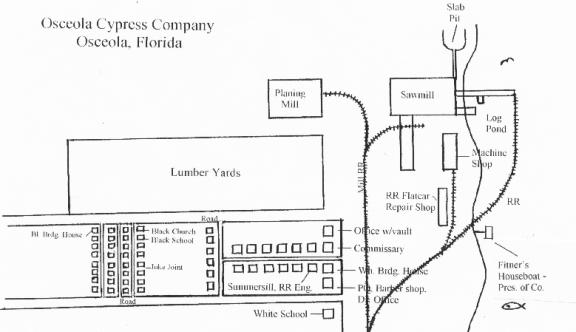
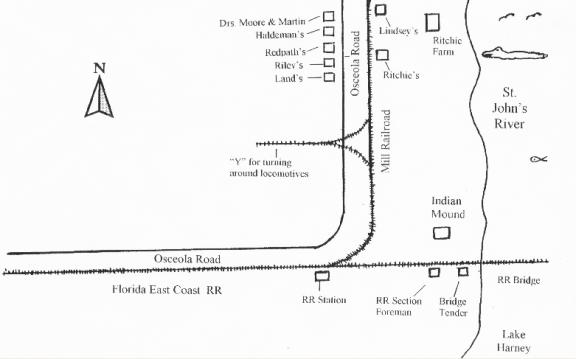
Return to
Geneva History page.
Home
Page 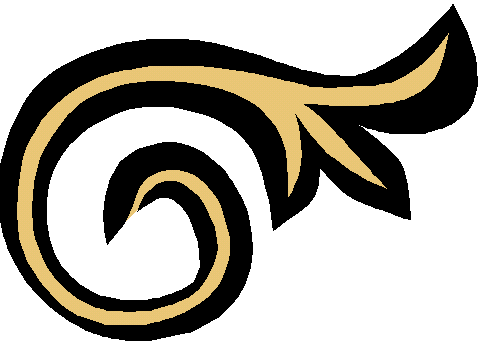 Genealogy
Genealogy  The Society
The Society  Museum
Museum  Books, T-Shirts,
etc.
Books, T-Shirts,
etc.
 Our
town was small and kinda isolated but we didn’t lack anything, you know; we
were kinda modern for those days. A
paved road brought you in and you went out the same way you came in.
At the end of the road you came face to face with the Big Mill (the
Industrial Park), a sawmill, planing mill, lumber yard and some small shops that
kept things in running order. There
were two big engines, No. 10 and No. 50. No. 50 had its own name, Summersill, because he was the driver. It
went on the East Coast Railroad Lines to far away places like Okeechobee to pick
up logs from the cypress swamps. No. 10 stayed on local tracks and moved the logs around.
They were dumped into a log pond on the St. Johns River and then were run
through the sawmill and planing mill, then to lumber yard to drier.
A funny little machine called a Ross Carrier moved the lumber around to
different places.
Our
town was small and kinda isolated but we didn’t lack anything, you know; we
were kinda modern for those days. A
paved road brought you in and you went out the same way you came in.
At the end of the road you came face to face with the Big Mill (the
Industrial Park), a sawmill, planing mill, lumber yard and some small shops that
kept things in running order. There
were two big engines, No. 10 and No. 50. No. 50 had its own name, Summersill, because he was the driver. It
went on the East Coast Railroad Lines to far away places like Okeechobee to pick
up logs from the cypress swamps. No. 10 stayed on local tracks and moved the logs around.
They were dumped into a log pond on the St. Johns River and then were run
through the sawmill and planing mill, then to lumber yard to drier.
A funny little machine called a Ross Carrier moved the lumber around to
different places.




